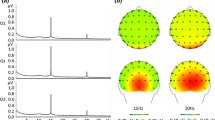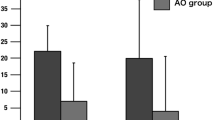Abstract
The posterior parietal cortex (PPC) is strongly related to task performance by evaluating sensory cues and visually guided movements. Sensorimotor processing is improved by task repetition as indicated by reduced response time. We investigated practice-induced changes in PPC visuomotor processing during a Go/NoGo task in humans using 306-channel magnetoencephalography. Eleven healthy adult males were instructed to extend the right index finger when presented with the Go stimulus (a red circle), but not to react to the NoGo stimulus (a green circle or a red square). Magnetic fields over the visual, posterior parietal, and sensorimotor cortices were measured before and after 3 days of task practice. The first peak of the visual-evoked field (VEF) occurred at approximately 80 ms after presentation of either the Go or NoGo stimulus, while a PPC response, with latency to a peak of 175.8 ± 26.7 ms, occurred only after the Go stimulus. No significant change in the first peak of VEF was measured after 3 days of task practice, but there was a significant reduction in the latency to peak PPC activity (160.1 ± 27.6 ms) and in the time from peak PPC activity to electromyogram onset. In all participants, practice resulted in a significant reduction in reaction time. These results demonstrate that practicing a sensorimotor task induces neuroplastic changes in PPC that accelerate sensorimotor processing and reduce motor response times.



Similar content being viewed by others
References
Amino Y, Kyuhou S, Matsuzaki R, Gemba H (2001) Cerebello-thalamo-cortical projections to the posterior parietal cortex in the macaque monkey. Neurosci Lett 309:29–32
Andersen RA, Snyder LH, Bradley DC, Xing J (1997) Multimodal representation of space in the posterior parietal cortex and its use in planning movements. Annu Rev Neurosci 20:303–330. doi:10.1146/annurev.neuro.20.1.303
Beurze SM, Toni I, Pisella L, Medendorp WP (2010) Reference frames for reach planning in human parietofrontal cortex. J Neurophysiol 104:1736–1745. doi:10.1152/jn.01044.2009
Buneo CA, Andersen RA (2006) The posterior parietal cortex: sensorimotor interface for the planning and online control of visually guided movements. Neuropsychologia 44:2594–2606. doi:10.1016/j.neuropsychologia.2005.10.011
Burnod Y, Grandguillaume P, Otto I, Ferraina S, Johnson PB, Caminiti R (1992) Visuomotor transformations underlying arm movements toward visual targets: a neural network model of cerebral cortical operations. J Neurosci 12:1435–1453
Cavada C (2001) The visual parietal areas in the macaque monkey: current structural knowledge and ignorance. Neuroimage 14:S21–S26. doi:10.1006/nimg.2001.0818
Creem-Regehr SH (2009) Sensory-motor and cognitive functions of the human posterior parietal cortex involved in manual actions. Neurobiol Learn Mem 91:166–171. doi:10.1016/j.nlm.2008.10.004
Deiber MP, Ibanez V, Sadato N, Hallett M (1996) Cerebral structures participating in motor preparation in humans: a positron emission tomography study. J Neurophysiol 75:233–247
Desmurget M, Epstein CM, Turner RS, Prablanc C, Alexander GE, Grafton ST (1999) Role of the posterior parietal cortex in updating reaching movements to a visual target. Nat Neurosci 2:563–567. doi:10.1038/9219
Endo H, Kizuka T, Masuda T, Takeda T (1999) Automatic activation in the human primary motor cortex synchronized with movement preparation. Brain Res Cogn Brain Res 8:229–239
Felleman DJ, Van Essen DC (1991) Distributed hierarchical processing in the primate cerebral cortex. Cereb Cortex 1:1–47
Hayashi S, Hasegawa Y, Kasai T (2002) Transcranial magnetic stimulation study of plastic changes of human motor cortex after repetitive simple muscle contractions. Percept Mot Skills 95:699–705
Hihara S, Notoya T, Tanaka M et al (2006) Extension of corticocortical afferents into the anterior bank of the intraparietal sulcus by tool-use training in adult monkeys. Neuropsychologia 44:2636–2646. doi:10.1016/j.neuropsychologia.2005.11.020
Hoshiyama M, Koyama S, Kitamura Y, Shimojo M, Watanabe S, Kakigi R (1996) Effects of judgement process on motor evoked potentials in Go/No-go hand movement task. Neurosci Res 24:427–430
Iacoboni M (2006) Visuo-motor integration and control in the human posterior parietal cortex: evidence from TMS and fMRI. Neuropsychologia 44:2691–2699. doi:10.1016/j.neuropsychologia.2006.04.029
Iacoboni M, Zaidel E (2004) Interhemispheric visuo-motor integration in humans: the role of the superior parietal cortex. Neuropsychologia 42:419–425
Inui K, Sannan H, Miki K, Kaneoke Y, Kakigi R (2006) Timing of early activity in the visual cortex as revealed by simultaneous MEG and ERG recordings. Neuroimage 30:239–244. doi:10.1016/j.neuroimage.2005.09.003
Kalaska JF, Crammond DJ (1995) Deciding not to GO: neuronal correlates of response selection in a GO/NOGO task in primate premotor and parietal cortex. Cereb Cortex 5:410–428
Karni A, Meyer G, Jezzard P, Adams MM, Turner R, Ungerleider LG (1995) Functional MRI evidence for adult motor cortex plasticity during motor skill learning. Nature 377:155–158. doi:10.1038/377155a0
Kato Y, Endo H, Kizuka T, Asami T (2006) Automatic and imperative motor activations in stimulus-response compatibility: magnetoencephalographic analysis of upper and lower limbs. Exp Brain Res 168:51–61. doi:10.1007/s00221-005-0090-2
Kertzman C, Schwarz U, Zeffiro TA, Hallett M (1997) The role of posterior parietal cortex in visually guided reaching movements in humans. Exp Brain Res 114:170–183
Kida N, Oda S, Matsumura M (2005) Intensive baseball practice improves the Go/Nogo reaction time, but not the simple reaction time. Brain Res Cogn Brain Res 22:257–264. doi:10.1016/j.cogbrainres.2004.09.003
Kida T, Wasaka T, Nakata H, Kakigi R (2006) Centrifugal regulation of task-relevant somatosensory signals to trigger a voluntary movement. Exp Brain Res 169:289–301. doi:10.1007/s00221-005-0141-8
Kurata K, Wise SP (1988) Premotor cortex of rhesus monkeys: set-related activity during two conditional motor tasks. Exp Brain Res 69:327–343
Moradi F, Liu LC, Cheng K, Waggoner RA, Tanaka K, Ioannides AA (2003) Consistent and precise localization of brain activity in human primary visual cortex by MEG and fMRI. Neuroimage 18:595–609
Mushiake H, Inase M, Tanji J (1991) Neuronal activity in the primate premotor, supplementary, and precentral motor cortex during visually guided and internally determined sequential movements. J Neurophysiol 66:705–718
Nakata H, Inui K, Wasaka T, Tamura Y, Akatsuka K, Kida T, Kakigi R (2006) Higher anticipated force required a stronger inhibitory process in go/nogo tasks. Clin Neurophysiol 117:1669–1676. doi:10.1016/j.clinph.2006.03.032
Nishitani N, Uutela K, Shibasaki H, Hari R (1999) Cortical visuomotor integration during eye pursuit and eye-finger pursuit. J Neurosci 19:2647–2657
Onishi H, Soma T, Kameyama S et al (2006) Cortical neuromagnetic activation accompanying two types of voluntary finger extension. Brain Res 1123:112–118. doi:10.1016/j.brainres.2006.09.033
Onishi H, Oyama M, Soma T, Kirimoto H, Sugawara K, Murakami H, Kameyama S (2011) Muscle-afferent projection to the sensorimotor cortex after voluntary movement and motor-point stimulation: an MEG study. Clin Neurophysiol 122:605–610. doi:10.1016/j.clinph.2010.07.027
Pascual-Leone A, Nguyet D, Cohen LG, Brasil-Neto JP, Cammarota A, Hallett M (1995) Modulation of muscle responses evoked by transcranial magnetic stimulation during the acquisition of new fine motor skills. J Neurophysiol 74:1037–1045
Petrides M, Pandya DN (1984) Projections to the frontal cortex from the posterior parietal region in the rhesus monkey. J Comp Neurol 228:105–116. doi:10.1002/cne.902280110
Sakata H, Taira M, Murata A, Mine S (1995) Neural mechanisms of visual guidance of hand action in the parietal cortex of the monkey. Cereb Cortex 5:429–438
Sasaki K, Gemba H (1991) Cortical potentials associated with voluntary movements in monkeys. Electroencephalogr Clin Neurophysiol Suppl 42:80–96
Schlaug G, Knorr U, Seitz R (1994) Inter-subject variability of cerebral activations in acquiring a motor skill: a study with positron emission tomography. Exp Brain Res 98:523–534
Shibata T, Ioannides AA (2001) Contribution of the human superior parietal lobule to spatial selection process: an MEG study. Brain Res 897:164–168
Snyder LH, Batista AP, Andersen RA (1997) Coding of intention in the posterior parietal cortex. Nature 386:167–170. doi:10.1038/386167a0
Stinear CM, Coxon JP, Byblow WD (2009) Primary motor cortex and movement prevention: where Stop meets Go. Neurosci Biobehav Rev 33:662–673. doi:10.1016/j.neubiorev.2008.08.013
Stocco A, Lebiere C, O’Reilly RC, Anderson JR (2012) Distinct contributions of the caudate nucleus, rostral prefrontal cortex, and parietal cortex to the execution of instructed tasks. Cogn Affect Behav Neurosci 12(4):611–628
Toni I, Schluter ND, Josephs O, Friston K, Passingham RE (1999) Signal-, set- and movement-related activity in the human brain: an event-related fMRI study. Cereb Cortex 9:35–49
Yotani K, Tamaki H, Yuki A, Kirimoto H, Kitada K, Ogita F, Takekura H (2011) Response training shortens visuo-motor related time in athletes. Int J Sports Med 32:586–590. doi:10.1055/s-0031-1275299
Author information
Authors and Affiliations
Corresponding author
Rights and permissions
About this article
Cite this article
Sugawara, K., Onishi, H., Yamashiro, K. et al. Repeated practice of a Go/NoGo visuomotor task induces neuroplastic change in the human posterior parietal cortex: an MEG study. Exp Brain Res 226, 495–502 (2013). https://doi.org/10.1007/s00221-013-3461-0
Received:
Accepted:
Published:
Issue Date:
DOI: https://doi.org/10.1007/s00221-013-3461-0




